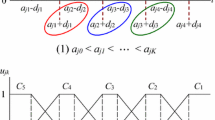Abstract
Based on the theory of attribute mathematics, this paper improves on the attribute interval evaluation theory. The main feature is that the evaluation index is an interval rather than a certain value. Using single index attribute analysis of the upper and lower limits of the interval, the paper proposes two calculation methods for the multiple index synthetic attribute measure. Based on the original AIET software, we develop a new set of software packages (NEW AIET) that can automatically complete a large number of calculations in a few seconds. Via engineering application, the accuracy and feasibility of geological disaster risk assessment are verified and can be used to better evaluate engineering disaster risk.


Similar content being viewed by others
References
Beard AN (2010) Tunnel safety, risk assessment and decision-making. Tunn Undergr Space Technol 25:91–94
Brown ET (2012) Risk assessment and management in underground rock engineering—an overview. J Rock Mech Geotech Eng 4(3):193–204
Bukowski P (2011) Water hazard assessment in active shafts in Upper Silesian Coal Basin mines. Mine Water Environ 30(4):302–311
Chen XT, Li L (2008) Prediction of tunnel rock burst based on AHP-FUZZY method. J China Coal Soc 33(11):1230–1234
Hwang JH, Lu CC (2007) A semi-analytical method for analyzing the tunnel water inflow. Tunn Undergr Space Technol 22(1):39–46
Li SC, Zhou ZQ, Li LP, Shi SS, Xu ZH (2013a) Risk evaluation theory and method of water inrush in karst tunnels and its application. Chin J Rock Mech Eng 32(9):1858–1867
Li SC, Zhou ZQ, Li LP, Xu ZH, Zhang QQ, Shi SS (2013b) Risk assessment of water inrush in karst tunnels based on attribute synthetic evaluation system. Tunn Undergr Space Technol 38:50–58
Li LP, Zhou ZQ, Li SC, Xue YG, Xu ZH, Shi SS (2014) An attribute synthetic evaluation system for risk assessment of floor water inrush in coal mines. Mine Water Environ 34(3):288–294
Li SC, Zhou ZQ, Li LP, Lin P, Xu ZH, Shi SS (2016) A new quantitative method for risk assessment of geological disasters in underground engineering: attribute Interval Evaluation Theory (AIET). Tunn Undergr Space Technol 53:128–139
Ministry of construction of the People’s Republic of China (2007) Guideline of risk management for construction of subway and underground works. China Architecture & Building Press, Beijing
Saaty TL (1980) The analytic hierarchy process. McGraw-Hill, International Book Co, New York
Song KI, Cho GC, Chang SB (2012) Identification, remediation, and analysis of karst sinkholes in the longest railroad tunnel in South Korea. Eng Geol 135–136:92–95
Søren DE, Per T, Jørgen K, Trine HV (2004) Guidelines for tunnelling risk management: international tunnelling association, working group No. 2. Tunn Undergr Space Technol 19(3):217–237
Sousa RL, Einstein HH (2012) Risk analysis during tunnel construction using Bayesian networks: porto metro case study. Tunn Undergr Space Technol 27(1):86–100
Wang Y, Yang WF, Li M, Liu X (2012) Risk assessment of floor water inrush in coal mines based on secondary fuzzy comprehensive evaluation. Int J Rock Mech Min 52:50–55
Wu LY, Yang YZ (2011) Improved grey correlative method for risk assessment on coal and gas outburst. In: 2011 International conference on computer and management, pp 1–4
Yang YH, Wu LY, Gao YC (2010) Extensible method of risk assessment of coal and gas outburst. J China Coal Soc 35(S1):100–104
Zhang LW, Zhang DY, Qiu DH (2010) Application of extension evaluation method in rock burst prediction based on rough set theory. J China Coal Soc 35(9):1461–1465
Zhou ZQ, Li SC, Li LP, Shi SS, Song SG, Wang K (2013) Attribute recognition model of fatalness assessment of water inrush in karst tunnels and its application. Rock Soil Mech 34(3):818–826
Zhou ZQ, Li SC, Li LP, Shi SS, Xu ZH (2015) An optimal classification method for risk assessment of water inrush in karst tunnels based on grey system theory. Geomech Eng 8(5):631–647
Acknowledgements
The research described in this paper was financially supported by the Natural Science Foundation of China (51879148, 51709159, 51911530214), the Fundamental Research Funds of Key Laboratory of Highway Technology and Safety Assessment of Shandong Province.
Author information
Authors and Affiliations
Corresponding author
Additional information
Publisher's Note
Springer Nature remains neutral with regard to jurisdictional claims in published maps and institutional affiliations.
Rights and permissions
About this article
Cite this article
Yang, W., Ding, R., Zhou, Z. et al. Improved Attribute Interval Evaluation Theory for Risk Assessment of Geological Disasters in Underground Engineering and Its Application. Geotech Geol Eng 38, 2465–2477 (2020). https://doi.org/10.1007/s10706-019-01162-y
Received:
Accepted:
Published:
Issue Date:
DOI: https://doi.org/10.1007/s10706-019-01162-y




